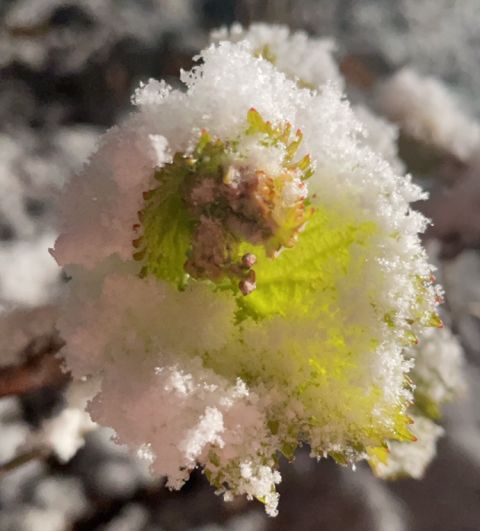14 October 2021 We are republishing this just to remind you why volumes of the 2021 harvest are likely to be so much smaller than usual.
12 April 2021 Greater Burgundy has been particularly badly hit by the early April frosts. But then it seems as though last week's frosts have been devastating for growers of vines and fruit trees in all French wine regions with the exception of Alsace.
Damaging frosts have come early this year in Burgundy. Cécile Mathiaud of the generic BIVB press office confirmed last Thursday afternoon that the entire region had been hit, with varying degrees of seriousness, from Chablis all the way south to the Mâconnais. The headlines will no doubt be about the Côte d’Or and the holy trinity of white-wine vineyards around Meursault, Puligny and Chassagne, but it is a picture of devastation up and down the region.
What has been especially devastating was not just the frost but the type of frost. Monday night was cold and dry with temperatures down to -3.9 °C (25 °F) in the coldest zones. A hard frost, but not a devastating one. However, the real story came on Tuesday night with more freezing temperatures and snow. The snow fell late in the evening, after ten o’clock, with 2 cm (0.8 in) freezing hard to the vines and significantly heightening the humidity in the air – meaning there was plenty of ‘wet air’ in freezing temperatures, which could freeze on the newly breaking buds and shoots. With clear skies and an unblemished sunrise at 7 am, the risk of burning the new shoots and leaves through refraction was huge, and apparently devastating. Attempts to create a smokescreen by burning hay bales had little effect.
Guillaume Boillot of Domaine Henri Boillot, who supplied both these images, summed it up in a word: catastrophique. Whereas the frost of 2016 was only locally devastating, last week none of the Côte de Beaune’s vineyards was spared, whether of village, premier cru or grand cru level. Boillot estimates his prospective losses at 60–80% with the meagre consolation that later-ripening parcels of Pinot Noir have been preserved. Candles, smudge pots and wind turbines failed to have any meaningful effect in raising temperatures against a glacial wind and pronounced humidity.
In Chablis William Fèvre’s director Didier Séguier related similar misery, with light rain on Monday evening followed by a temperature drop to -8 °C and on Tuesday snow with temperatures of -7 °C. Burgeoning leaves literally froze on the vine, before being scorched by early-morning sun.
Chablis’ entire vineyard has been hit, even if, unusually, it was the higher sites on the plateau, not the lower slopes, that were hit hardest. ‘Hardest’ is a relative term here: it is thought that 50% of Chablis’ potential crop has been completely destroyed and of the remaining 50%, losses are estimated at 50–80%. If the Chardonnay vines were to produce fruit from secondary shoots, Séguier notes, it is a notoriously poor variety for replacement crops, with a best-case scenario yield of 20% (of a normal crop).
But the vines still need to be tended, preserved for the future and everyone paid. In a grim irony, many producers do take out insurance against frost damage but as pay-outs are based on the average yield over five years (only 2018 has offered Chablis a full crop in the last five years), the remuneration will be meagre. Lean times ahead.
Further south in the Mâconnais at Vinzelles, Jean-Philippe Bret of Bret Brothers and Domaine de la Soufrandière writes that they too were affected differently on each of the two nights. As in Chablis, Tuesday night’s frost was most severe on summits of the Mâconnais hills. Winegrowers were again surprised but Bret explains this by the evacuative effect of a dry wind that persisted all night down the Saône Valley.
Verzy-Igé has suffered up to 100% losses similar to more northerly sectors such as Cruzille, la Côté de Bray and the Vallée de Grosne. He writes that at such extreme temperatures (at least minus six), workers’ efforts to dissipate the cold and raise the temperature through candles, burning hay, wind machines or even helicopters were in vain.
Wednesday’s second night of frost was even harder, the temperature descending to -8 °C, and without Tuesday’s locally mitigating wind, the frost not only doubled-down its effect on the hilltops, but ran amok on the hillside vines as well.
He notes that there is great variability according to zone, and particularly orientation, elevation and when the vines were pruned. In early-pruned vines where leaves were manifestly open, damage has been greater; vines pruned later whose buds remain largely dans le coton (barely formed) have fared better.
It’s too early to assess total damage, but Bret relates that south- and south-east-facing vineyards at elevation have been most severely affected, with losses in the southern Mâconnais as high as 100%.
Across southern Burgundy as a whole the frosts were widespread with variations of 20–100% crop loss reported. Northern Beaujolais has been little affected as Gamay buds later.
The end of last week saw a moderate rise in the mercury but, alas, the threat is not yet over. Rain this weekend will increase humidity in the vineyards and more snow and sub-zero temperatures are forecast for the start of this week, and a probable repeat of last week’s knife-edge conditions. Tuesday, Wednesday and Thursday are expected to bring hard frosts and we are still more than a month away from the traditional safety marker of the Ice Saint’s day on 13 May.
The BIVB plans to publish a full evaluation of frost damage on Tuesday 13 April. Let us hope for a frost-free month thereafter.














